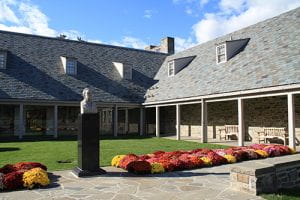Home of Franklin D. Roosevelt National Historic Site And National Archives
First I would like to welcome everyone to the Franklin D. Roosevelt national historic site, located in Hyde Park in New York, right off Albany post Road on Route 9G. Here at the wonderful site of FDR there are a couple of buildings that make the FDR home unique. To help learn about FDR and his home life we have the FDR home called Springwood. This is the home of FDR as a child and later on his home away from the White House. The second place is the Presidential Library and Archives center, where you can tour through the library and also do research in the archives about FDR’s and also Eleanor Roosevelt’s life. And then you also have the Education center which I help assist with everyday for my internship. Through all of this, we will see some central issues of this historical site and also see how they have come together.
Although everything always looks amazing at the FDR home, there are some central issues this site reflects and approaches to how they make it work. When the FDR home opened in 1945, Eleanor Roosevelt gave the archives to the National Archives and the home of FDR to the National Park Services. This created not a bad animosity between the two, but a friendly one. There are about seventeen and a half million documents and artifacts, thirtyfive thousand objects, fifty thousand books, and twenty three thousand of them written by FDR himself and his own collection. With all of these artifacts at the FDR estate, when events happen, the two different associations would collaborate on ideas and sometimes one wants a different thing and another wants another thing done. Sometimes coming together tends to impact things but in the end the events come out on top. Sometimes it’s also hard to gain materials that the National Park Services has because its administration is tougher to go through. Also before the head of the national park changed, the former president of the estate would keep everyone separated in their different departments and it made it very hard for people to work together. Until recently when the president had changed, all the different departments started collaborating and working together on making the FDR home and Presidential Library come together as one to help create the story of FDR’s life.
There is also some central historical exploration that happens at the FDR estate too. Two of areas of interest include Japanese Internment Camps and The Bombing at Pearl harbor. Some writers who work in the archives over at the Presidential library at the FDR estate, question if Japanese internment was necessary or not, and if FDR could have avoided the bombing at Pearl Harbor. These topics are also on display at the library under the title: Confront the Issues. Every year there is a reading festival at the FDR estate, and almost every year they have someone come in after doing their research in the library to talk about these two topics.
These are some of the central issues today that happen at the Franklin D. Roosevelt National park. If there are other scholars who are interested in these topics, you can visit the home and look at the  Confront the Issues topic in the Presidential Library.
Confront the Issues topic in the Presidential Library.